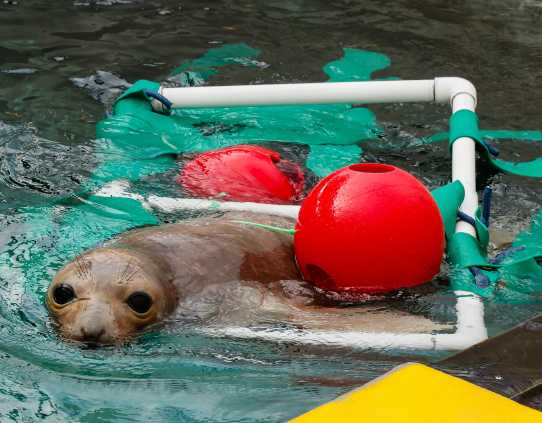
Animal Enrichment in Rehabilitation
Experts at The Marine Mammal Center help seal and sea lion patients develop crucial survival skills by providing behavioral enrichment as part of their care.
By observing how patients interact with animal enrichment, our researchers are gaining insights that will ultimately improve rehabilitation, animal welfare and conservation efforts, as well as contribute to vital, growing knowledge around marine mammal behavioral health.
What Is Behavioral Enrichment?
To ensure our patients are prepared—physically and mentally—to thrive in the wild, experts at The Marine Mammal Center incorporate behavioral enrichment into rehabilitation. Enrichment is any stimulus or activity that aims to improve the physical and psychological health of an animal. And as an educational tool during rehabilitation, enrichment encourages species-typical behaviors while helping an animal develop crucial problem-solving and survival skills.
Our animal care experts use their behavioral knowledge to design innovative enrichment for specific species. For example, endangered Hawaiian monk seals are known to hunt in the wild by flipping over rocks to access their prey. By interacting with feeding boxes where they must flip open a panel to reach a fish, our patients can develop and engage in the hunting skills they will need after they are released.
Items that float in the pool, such as imitation kelp and balls with fish hidden inside, are another form of seal and sea lion enrichment that encourages our patients to spend time in the water exploring their environment and learning to forage for food.
Other enrichment items at our hospital include a floating raft, which helps seals learn to haul out, and out-of-water enrichment that engages behaviors observed in wild northern elephant seals like interacting with dangling tree branches.
Learning Survival Skills
Enrichment is especially important for orphaned pups that might not have had the chance to learn important survival skills, like diving and hunting for food, before arriving at our hospital for care. To develop these skills in a more complex foraging environment, some Pacific harbor seal pup patients get their meals served in a feeding box at the bottom of the pool.
A study conducted at our hospital in 2016 suggested that harbor seal pups that interacted more with enrichment learned how to hunt for food on their own more quickly than their pen-mates that didn’t engage. Researchers have since expanded this behavioral health study to include northern elephant seals.
Meet One of Our Patients
Northern elephant seal pup Shrub was found on a beach malnourished and suffering from a dangerous parasite. Thankfully, she was rescued and brought to our hospital where she received the medical care she desperately needed to heal.
Part of Shrub’s rehabilitation involved engaging in marine mammal enrichment activities to develop natural behaviors and critical survival skills. Enrichment items like imitation kelp and balls with fish hidden inside encouraged problem-solving and exploration of her environment.
After months of care, Shrub was ready for life in the wild where she could venture into the open ocean and dive to amazing depths foraging for food.

Cognitive Trials
What types of animal enrichment best help seals develop problem-solving skills? Researchers use cognitive trials to answer this question.
To compare different kinds of enrichment, one group of seals is provided with structural enrichment that encourages exploration and sensory stimulation, such as a raft or imitation kelp, while another group is provided with cognitive enrichment that includes a problem-solving element, such as a feeding box. The two groups then participate in cognitive trials, where they are introduced to a completely new item with fish hidden inside.
By observing how quickly the seals learn how to get fish out of the new enrichment item, our researchers can gain key insights into the seals’ problem-solving skills resulting from various enrichment sessions over time.
Enrichment Research at The Marine Mammal Center
{"image":"\/Animals\/Patients\/Harbor seals\/hs-by-bill-hunnewell-c-the-marine-mammal-center.jpg","alt":"harbor seal in a life preserver enrichment item","title":"Enrichment as a Tool for Rehabilitating Harbor Seals","link_url":"https:\/\/www.marinemammalcenter.org\/publications\/enrichment-as-a-tool-for-rehabilitating-harbor-seals","label":"Research Paper","type":"publication"}

Feeding Cues
In the wild, animals use environmental cues to help them gather information and make decisions. And when an animal makes the connection between a cue and a reward, they develop a learned association that helps them continue making informed choices.
As part of the behavioral health study at our hospital, trained volunteers turn on water misters (the cue) at our seal patients’ mealtime (the reward). Researchers measure learned associations to the feeding cue by observing the seals’ behavior, such as increasing vocalizations and approaching the pen door, in anticipation for mealtime.
These observations can help veterinarians better understand an animal’s emotional state during rehabilitation. By incorporating feeding cues, we also help the patients practice their associated learning process while reducing the connection between humans and food, giving the animals a better chance at survival in the wild.



